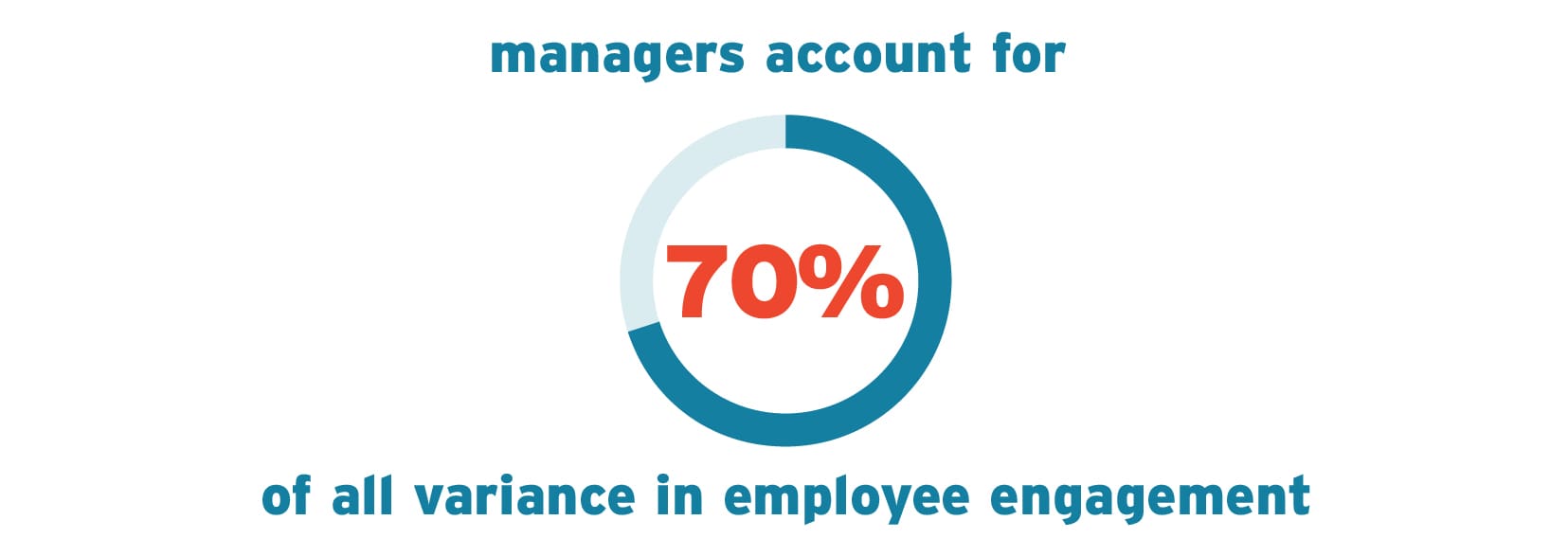
Compare Providers
Download our outplacement comparison sheet
Request Pricing
Compare our rates to other providers
Hey there, HR land.
Welcome to a new edition of our famous #HRBookClub series.
I’ve been busy the last month frolicking around in the fall leaves, drinking hot cocoa, and reading my new favorite HR book: It’s The Manager.
The book was written by Jim Clifton and Jim Harter and was based on a study from Gallup.
I choose this as our next book club read because the description on Amazon spoke to me. I have spent so much time reading, writing, and talking about employee engagement in the last year. But I felt like I hadn’t heard a study about employee engagement that really capitalized on what I’ve always believed to be true:
Overall company employee engagement matters. But, managers and engagement on your team matter a lot, too. And I feel like employee engagement experts really only focus on the former.
I’ve had this experience, and I’m sure several of you have, too. You love the company, the benefits it provides, its mission, and everything else. But, your boss, or your team, is just not what you want it to be.
For me, that wasn’t enough to keep me around in the past. Even though the company was doing everything it possibly could from a high level to keep employees engaged.
And this exact scenario is what It’s The Manager is based on.
Here are my top takeaways from this read:
It Really Is the Manager
It literally says on the cover of this book: “Gallup finds that the quality of managers and team leaders is the single biggest factor in your organization’s long-term success.”

And later in the book, we find out that managers account for 70 percent of all variance in employee engagement.
You heard that right, HR folks! Our country doesn’t have an employee engagement problem. We have a manager problem.
Companies Have Stopped Growing Internally and Now Hire to Achieve Growth
Why? Because our managers just aren’t good at coaching. And you need coaches who can get the best ideas, productivity, and innovation from their employees to foster organic growth.
And HR should care about this because if your managers could become better coaches, there would be so much room for growth. Your employees, and your competitor’s employees, all probably have similar levels of engagement and productivity.
So what would happen if all of a sudden your employees were able to double those stats? Magical things that would set you apart in the market would start to happen at an unforeseeable rate.
This Book Isn’t a Page-Turner, But Rather a Guide
I was expecting to attach onto a narrative in this read, but the authors didn’t structure it like that.
They split the book up into five sections: The Future of Work, Boss to Coach, Employment Brand, Culture, and Strategy. And in those five sections, there are a bunch of subsections that cover a range of topics. The subsections aren’t that long – maybe only a page or two.
It was created in this way so that CEOs and CHROs could use the book as a guide, and go through the index of subsections, to find solutions for any particular problem they are facing.
When Managing, Focus on People’s Strengths. Not Their Weaknesses
The book talks for a long time about how bad all of our managers are. And I was starting to get a little anxious thinking about how exactly we were going to solve that problem.
But then they start providing some solutions. And they really came through in a big way.
My first takeaway was to really manage strengths. As managers, we are so focused on helping people correct their weaknesses – because that’s how we think we will help them grow – and that’s actually a bad mindset to have.
Now, I’m not saying managers should never give negative feedback. People still need to know what they are doing wrong and how they can improve.
But studies show that people can only improve their weaknesses by a little bit over their lifetime. On the flip side, people can improve their strengths several times over based on how much time they spend honing those strengths. Your managers should be trained to spend more time coaching people on their strengths then they are going over their weaknesses.
Use the StrengthFinders Assessment. Then Coach Based on Those Strengths
Sometimes it can be hard to reflect on your strengths and weaknesses. And generally, people like to think about their strengths in a very tactical way. For example, I’m great at developing content.
But that tactic speaks to a larger thing that I’m good at, which the assessment helped me realize.
Here are my strengths, according to the book:
- Achiever
- Maximizer
- Futuristic
- Strategic
- Activator
- Woo
The book has several pages of advice on how I, as a leader, should manage with these strengths. It then has several pages on how I should manager others based on the specific strengths they have.
I had my content manager take the test, and in the guide, it said for three of his strengths that I should give him quiet time to be reflective and think about the big picture. When I told him this idea, he was immediately excited. Because he knew himself well enough to know that this would provide a ton of value to our team.
And if you really think about it, giving someone a few hours of quiet time every week is not that intensive for a leader. It was really a win-win.
The Final Takeaway: Managers Need to Stop Managing and Start Coaching
If we can switch the mentality of managers to start acting like coaches. Their team’s development will soar!
Here are the three requirements of coaching:
- Establish expectations
- Continually coach
- Create accountability
These are so simple. But if you break down the time you spend with your direct reports into these sections, you’ll really see a difference in how effectively you’re helping them grow.

And studies show that if employees talk often with their bosses about their goals, and receive feedback often, too, they are so much more engaged and productive.
Speaking of spending time with your direct reports, here are the five types of conversations you should be having:
- Role and relationship orientation: This is where you talk about their strengths, go over the coaching style, and ask initial questions about their goals and aligning with company objectives.
- Quick connect: This can be as quick as a 10-minute call, and it for the employee to bring any roadblocks to the manager’s attention, that way they can continue achieving their goals at the desired pace.
- Check-in: These are a little bit more planned than the off the cuff quick connects, and are a place to talk about overall projects and not just roadblocks.
- Developmental coaching: This is the meat and potatoes of this management style. You should give feedback, create action plans for improving strengths, and talk about the employee’s career path and goals. Make sure to only focus a fraction of the time on weaknesses.
- Progress reviews: All HR folks should be familiar with these. They are akin to your normal performance management reviews. Except you should have them more than just once a year! Aim for 2-4 times annually.
And there you have it! These were my top takeaways. But, I have to tell you, there is so much more in this book, these are just the points that resonated with my experience. Make sure to check it out, and let me know your own thoughts!
In need of outplacement assistance?
At Careerminds, we care about people first. That’s why we offer personalized talent management solutions for every level at lower costs, globally.


